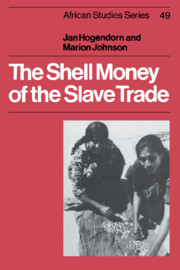Book contents
- Frontmatter
- Contents
- Maps
- Tables and chart
- Preface
- Introduction
- 1 The cowrie
- 2 The Maldive Islands
- 3 The Portuguese domination
- 4 The Dutch and English enter the trade (seventeenth century)
- 5 Prosperity for the cowrie commerce (eighteenth century)
- 6 Boom and slump for the cowrie trade (nineteenth century)
- 7 Collection, transport and distribution
- 8 Cowries in Africa
- 9 The cowrie as money: transport costs, values and inflation
- 10 The last of the cowrie
- Notes
- Bibliogaphy
- Index
8 - Cowries in Africa
Published online by Cambridge University Press: 12 October 2009
- Frontmatter
- Contents
- Maps
- Tables and chart
- Preface
- Introduction
- 1 The cowrie
- 2 The Maldive Islands
- 3 The Portuguese domination
- 4 The Dutch and English enter the trade (seventeenth century)
- 5 Prosperity for the cowrie commerce (eighteenth century)
- 6 Boom and slump for the cowrie trade (nineteenth century)
- 7 Collection, transport and distribution
- 8 Cowries in Africa
- 9 The cowrie as money: transport costs, values and inflation
- 10 The last of the cowrie
- Notes
- Bibliogaphy
- Index
Summary
When the slave trade to the New World reached large proportions in the seventeenth century, the imported cowrie currency was already in use over a large zone of circulation in West Africa. The zone itself was expanding, and the eighteenth-century peak in the slave trade was without question a major reason why cowrie imports also reached record levels in the same century. After quiescence early in the nineteenth century, the zone of circulation continued its expansion until the time of the great inflation. In this chapter, we shall view this large currency area and trace its growth and decline.
In Africa, as on other continents, cowries were used as ornaments, charms, ritual objects, or for magical purposes more widely, but of course in very much smaller numbers, than they were as money. As this aspect of their use is of little relevance to the shell money of the slave trade, it will not be discussed here. Nor shall we more than mention the circulation of cowries beyond the bounds of their main zone. We have already noted in chapter 1 that this currency found some substantial use apart from its West African heartland. Far to the south in the Kingdom of Kongo, for example, imported cowries at one period devalued the traditional zimbo (nzimbu) shell money from the island of Luanda. David Birmingham interprets the use of nzimbu shells as currency in the Kongo Kingdom as a result of Portuguese influence, whereas previously they had only been “part of the royal treasure.”
- Type
- Chapter
- Information
- The Shell Money of the Slave Trade , pp. 101 - 124Publisher: Cambridge University PressPrint publication year: 1986

